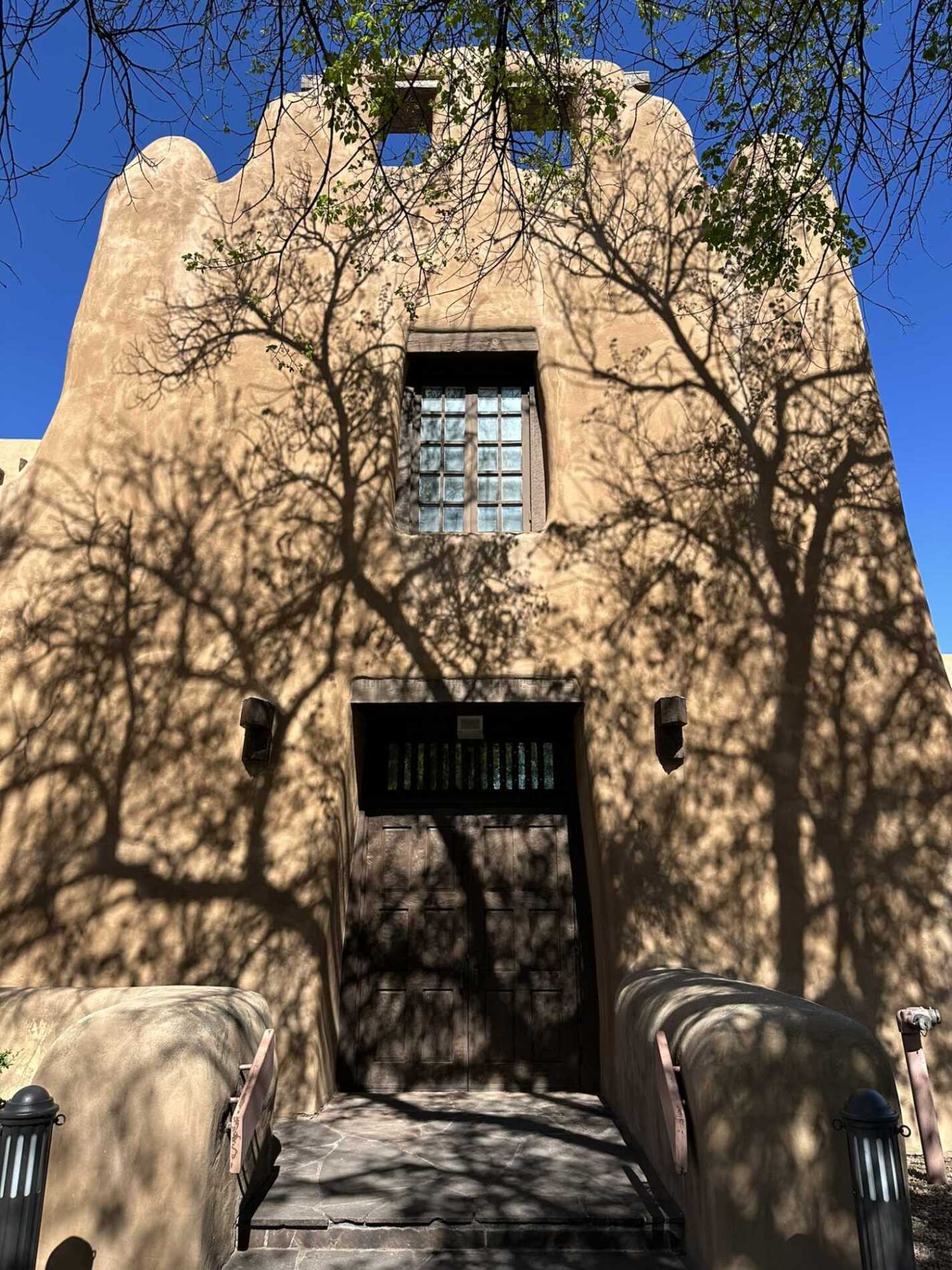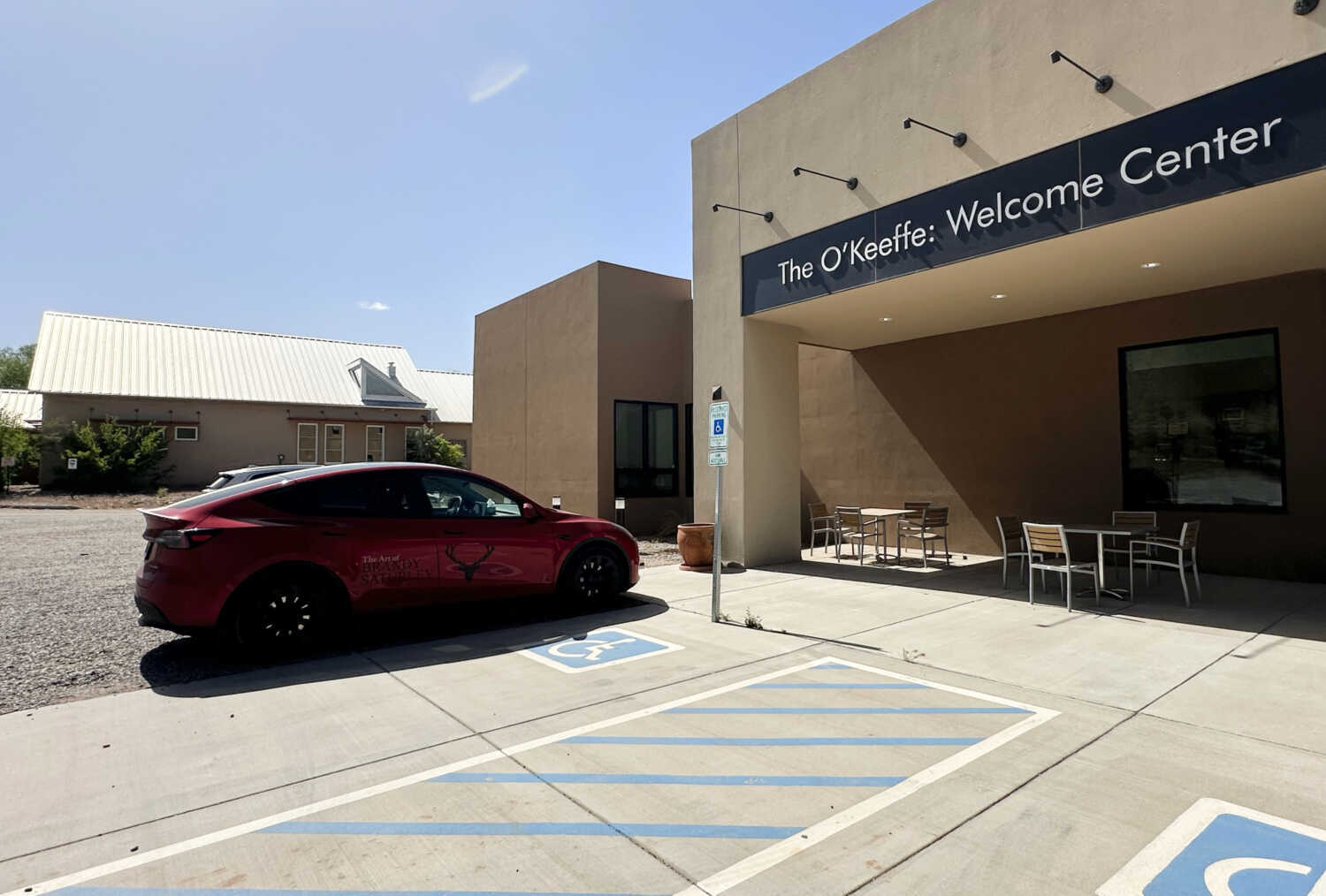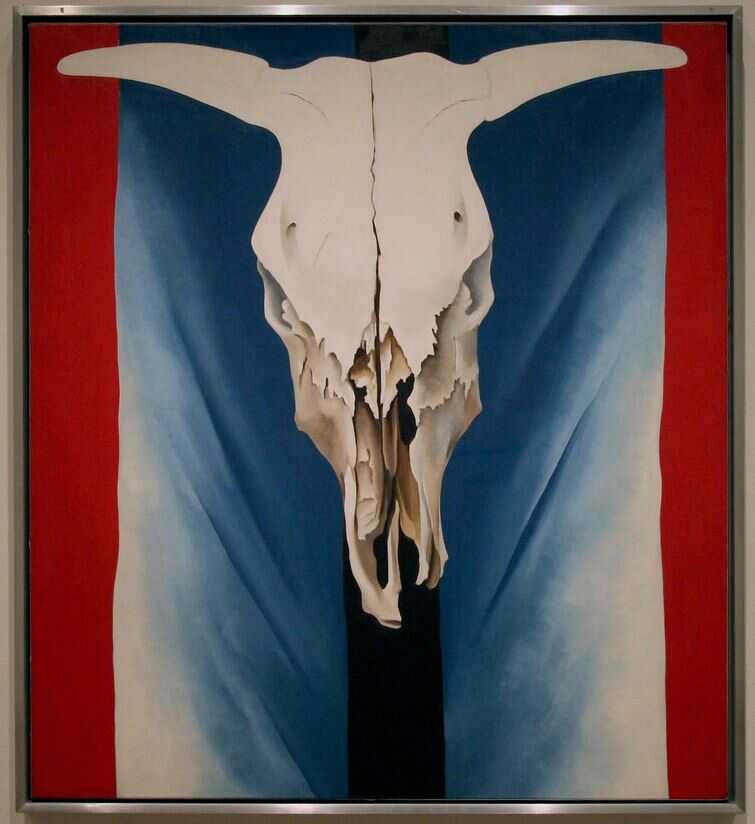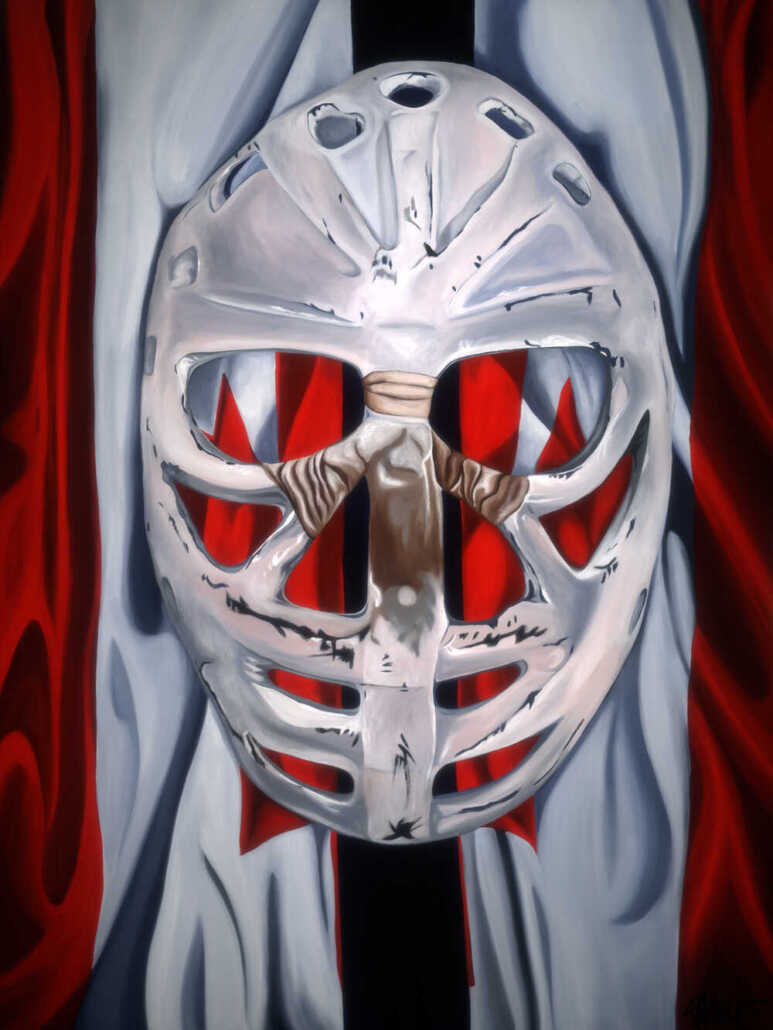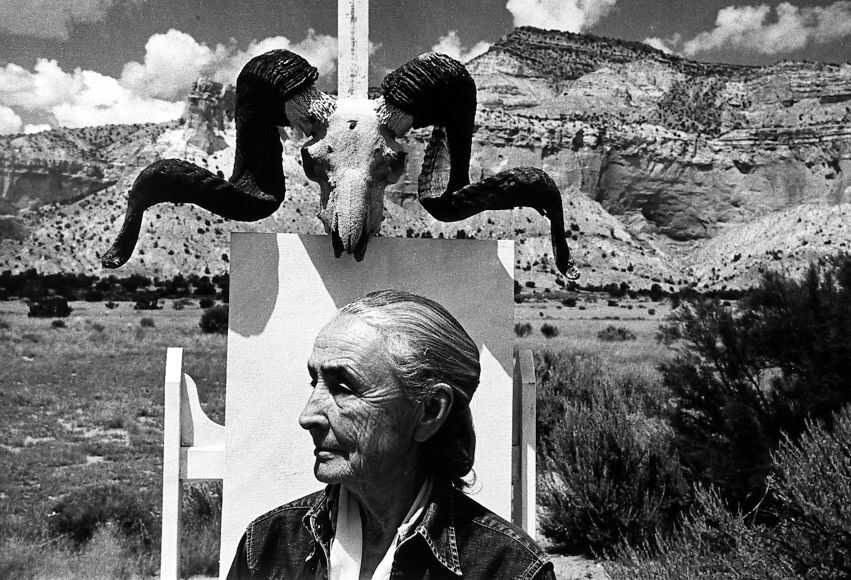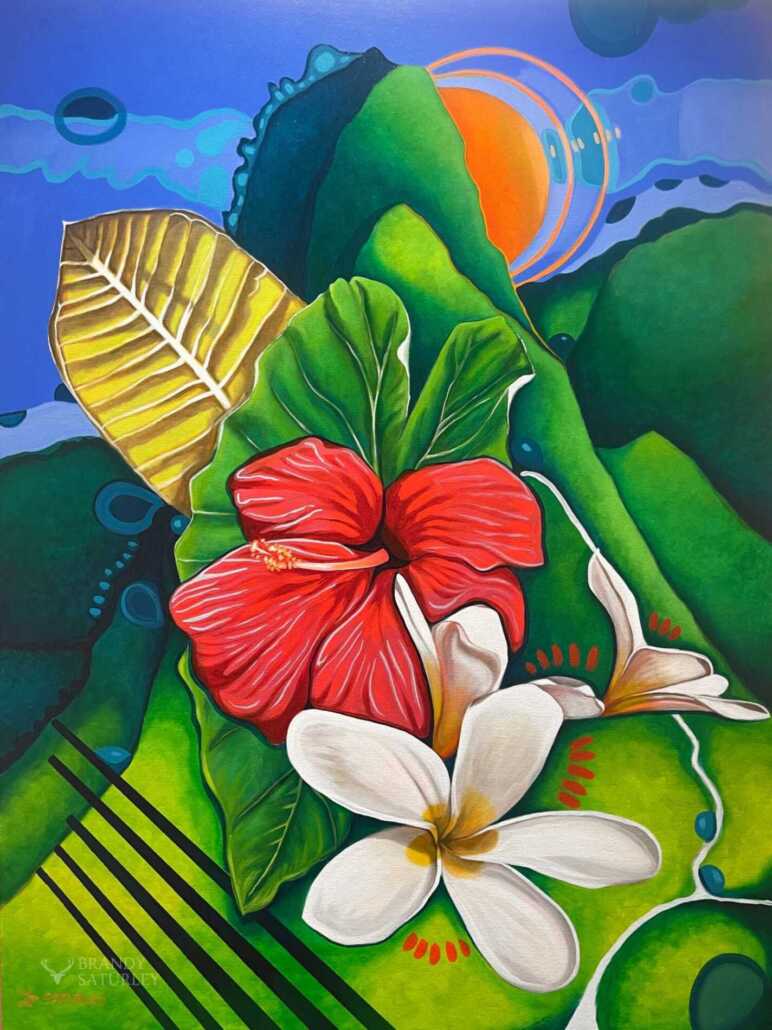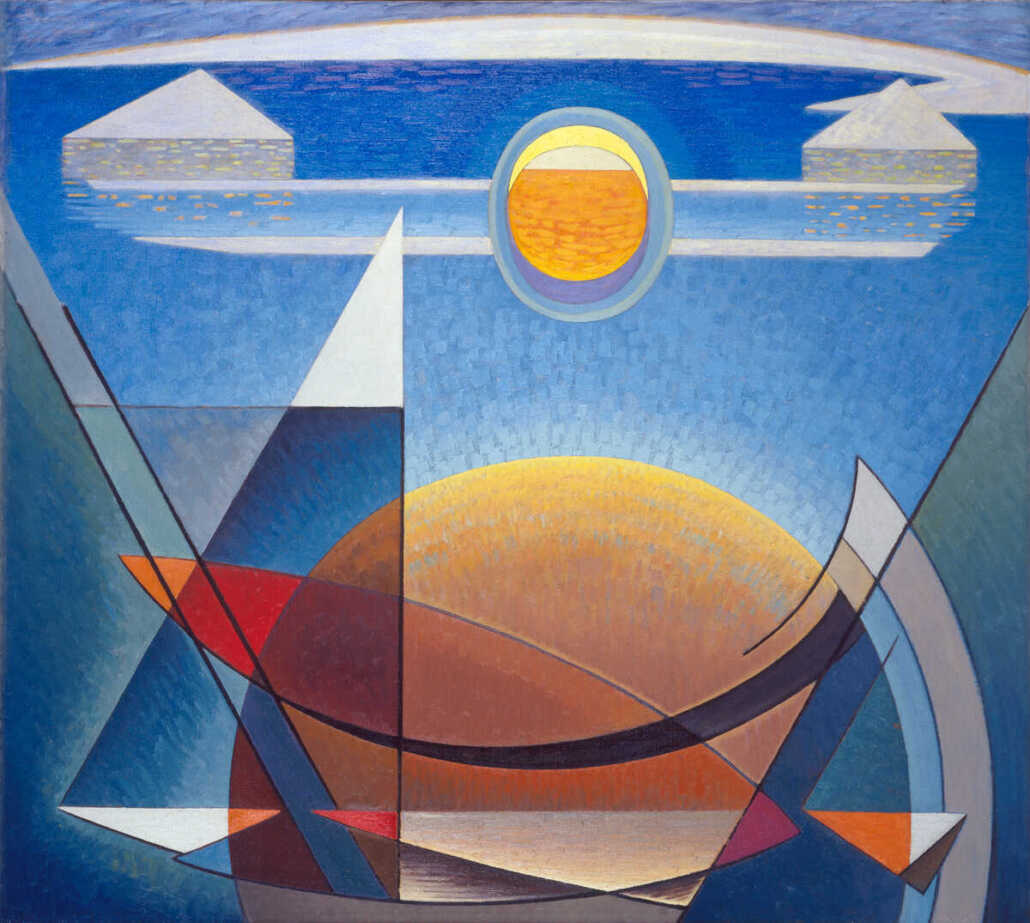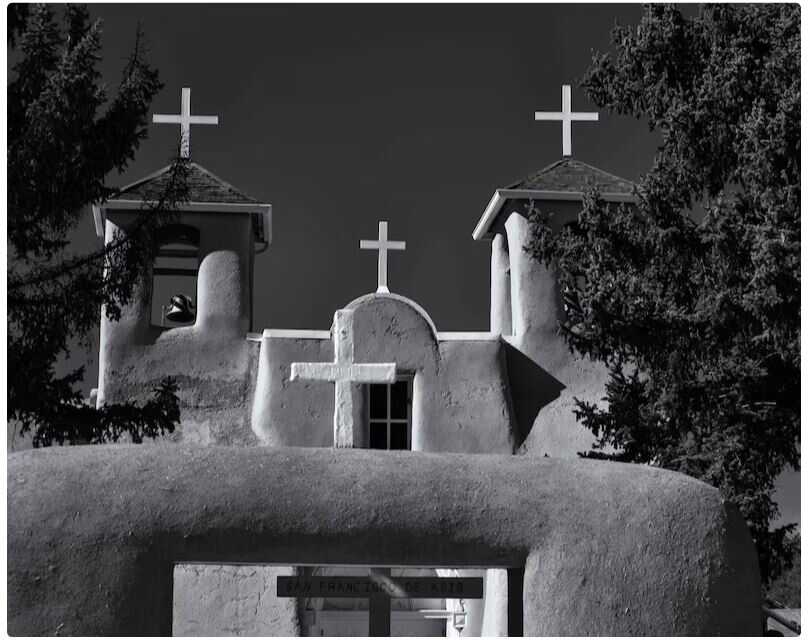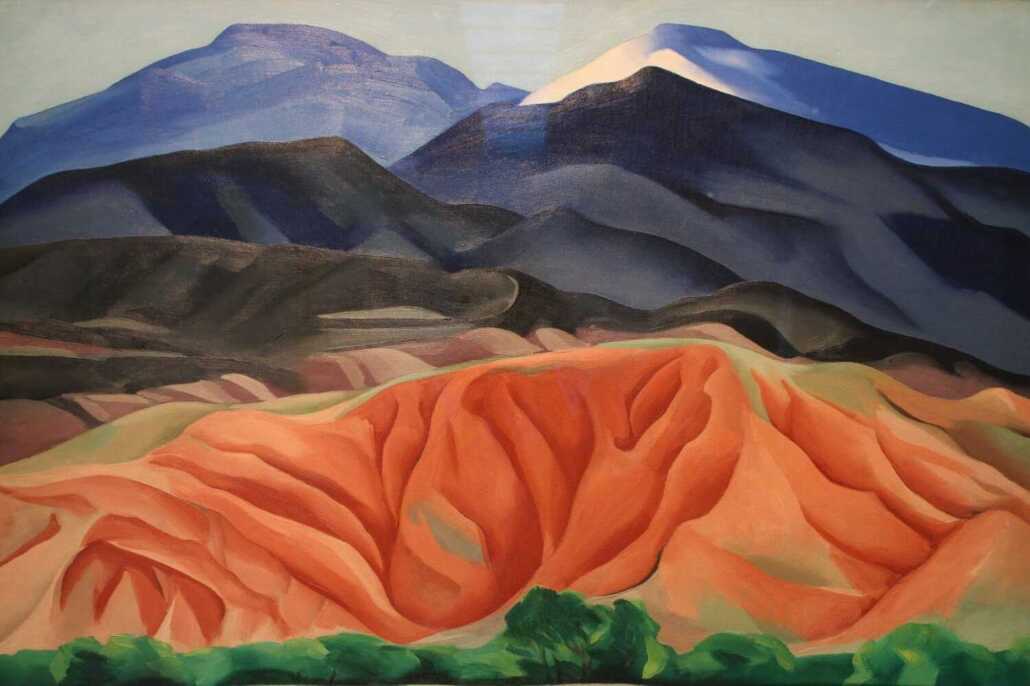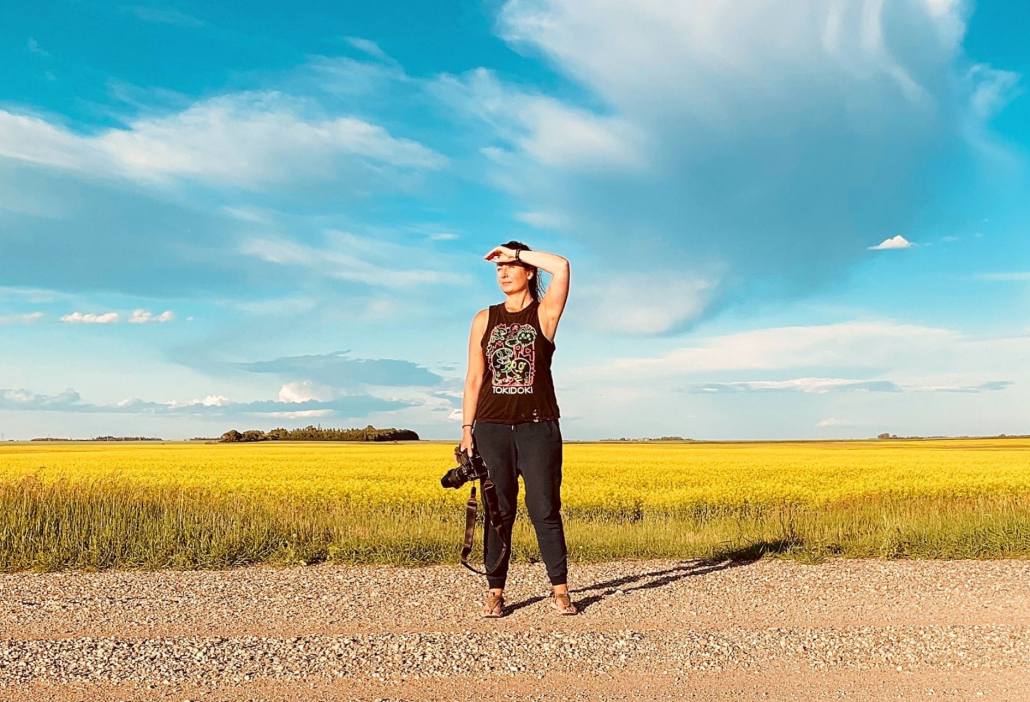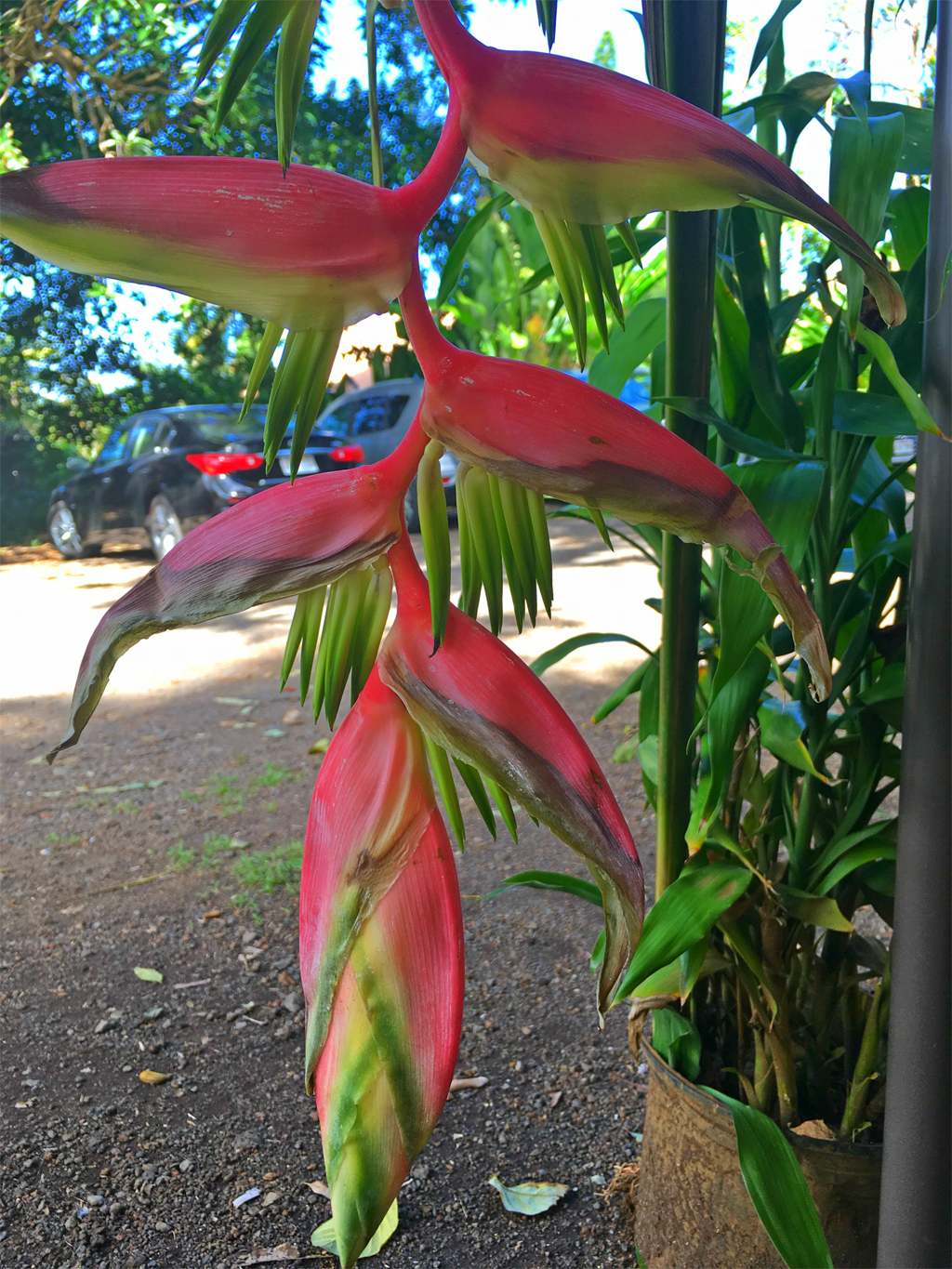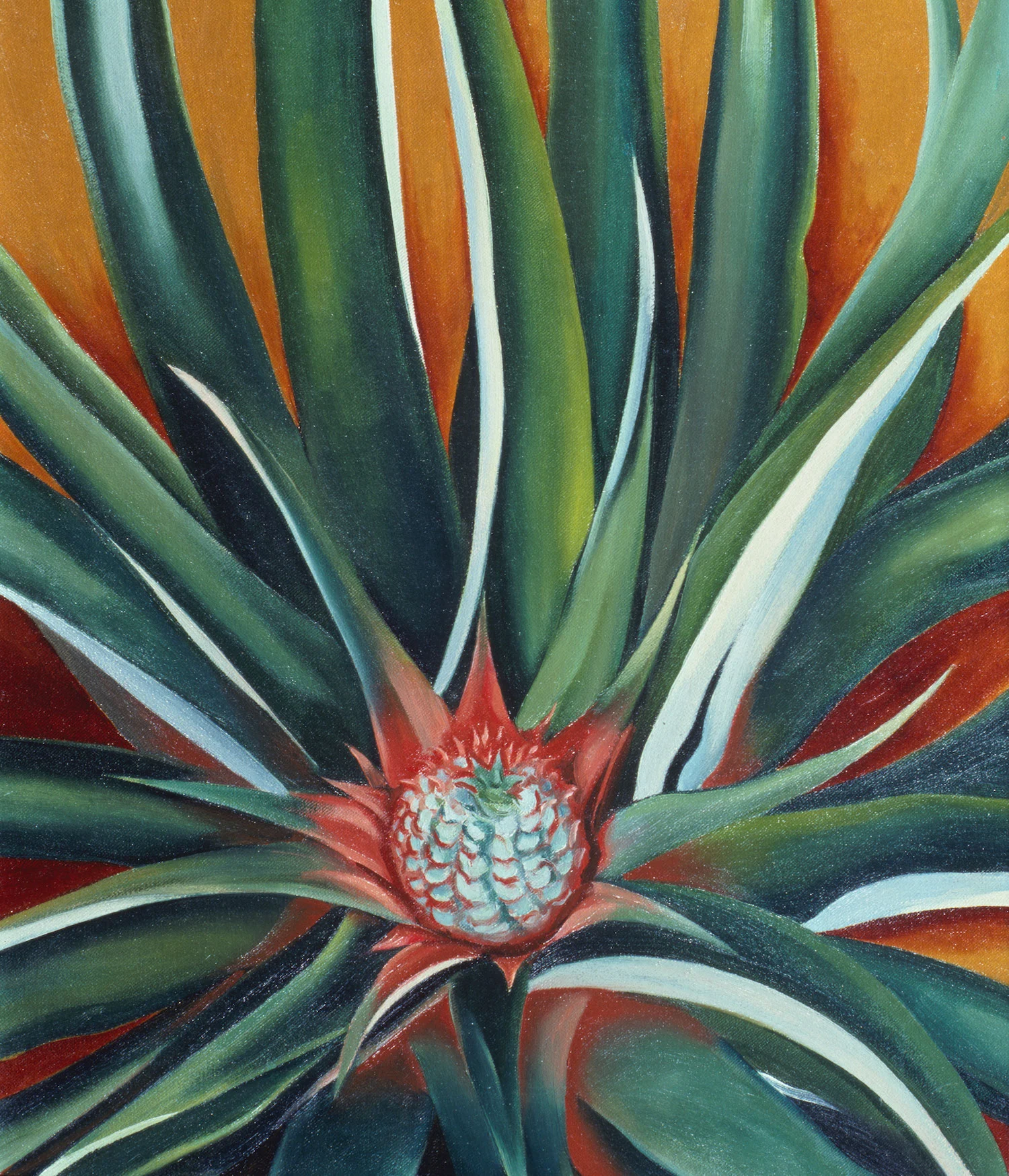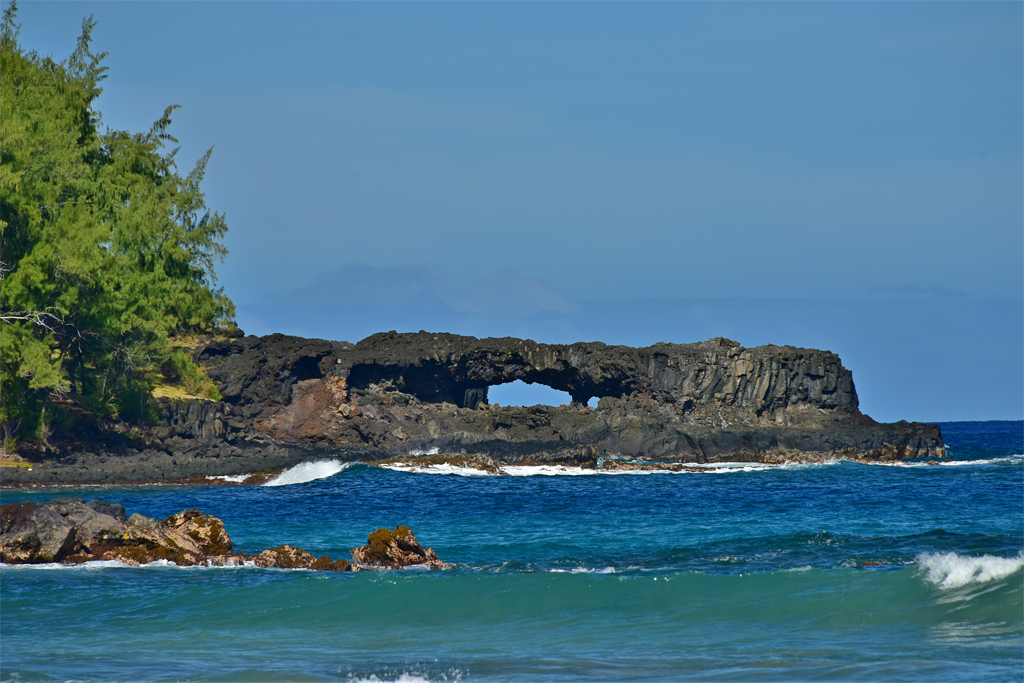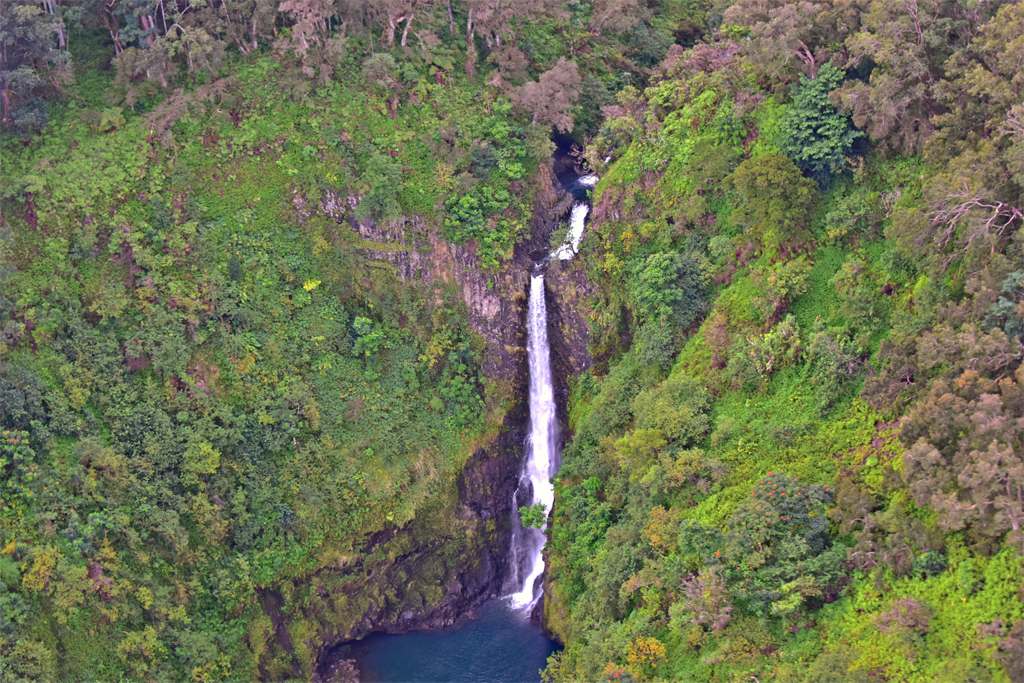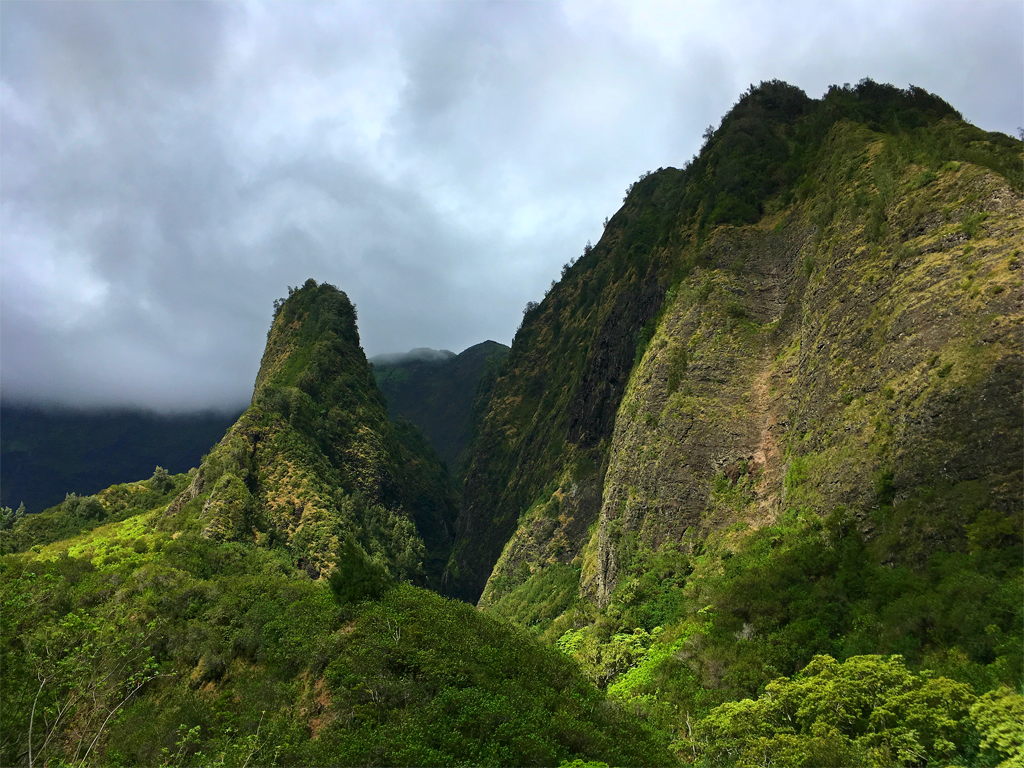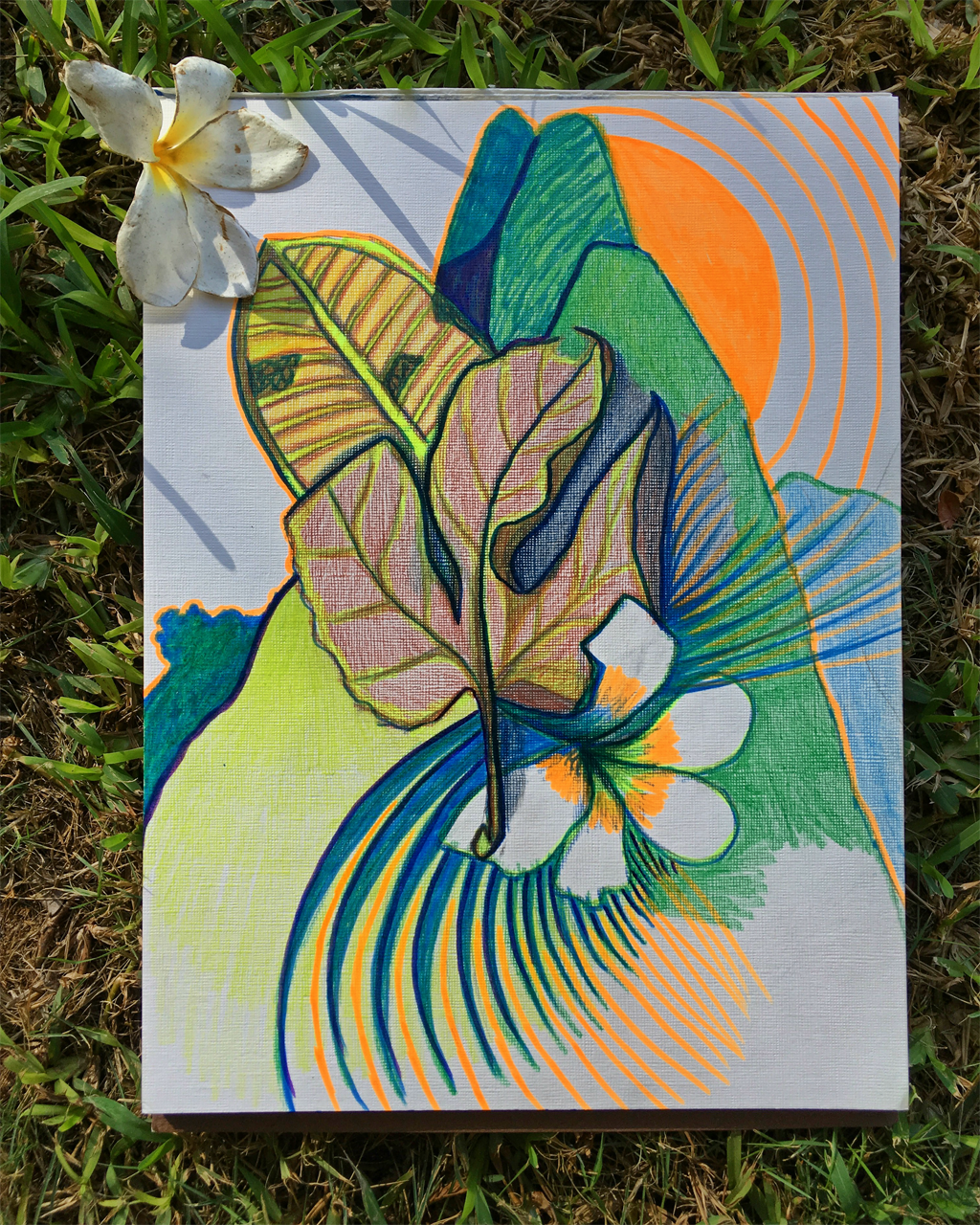My Trip to Abiquiu, New Mexico: A Conversation With Georgia O’Keeffe
After months of planning, May first finally arrived. We packed the Tesla with all our gear, provisions, and most importantly, pillows. With the passenger window tripod securely affixed, we set out on a long-awaited journey. I’ve written countless times about my deep admiration for Georgia O’Keeffe, the iconic American modernist painter celebrated for her vibrant depictions of flowers and the desert landscapes, flora, and fauna of New Mexico. Though my studio and home are on Vancouver Island along the Pacific Northwest Coast, our path would take us diagonally across seven states, culminating in Santa Fe, New Mexico. On my way to have a conversation with Georgia O’Keeffe.
Our destination, New Mexico, particularly the enchanting locale of Abiquiú, has a rich history. Settled by Tewa Pueblo families and the Roman Catholic Church in 1742, Abiquiú is known as “wild chokecherry place” in the Tewa language. The vivid canyons and majestic mountains surrounding Abiquiú have served as the backdrop for numerous films, including Red Dawn, Silverado, Lonesome Dove, City Slickers, 3:10 to Yuma, No Country For Old Men, Indiana Jones and the Kingdom of the Crystal Skull, Cowboys & Aliens, The Lone Ranger, and Breaking Bad.
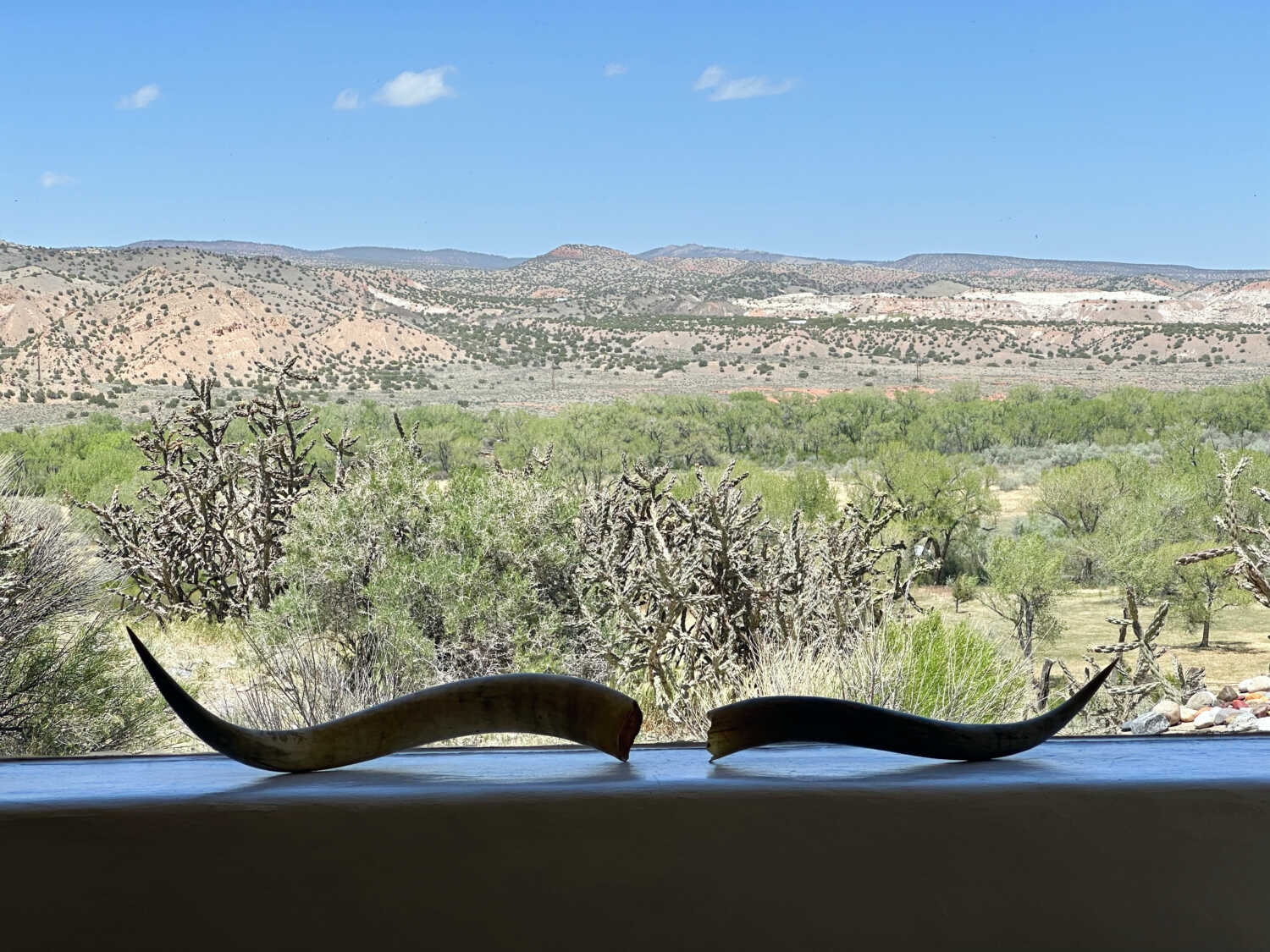
Georgia O’Keefe studio in Abiquiu, New Mexico – Brandy Saturley 2024
We arrive in Santa Fe on Cinco de Mayo and are greeted by a parade of Chicanos and Mexican Americans proudly and literally rocking their meticulously painted low-riders. A lowrider is a customized car with a lowered body that emerged among Mexican American youth in the 1940s. Lowrider also refers to the driver of the car and their participation in lowrider car clubs, which remain a part of Chicano culture and have since expanded internationally. These customized vehicles are also artworks, generally being painted with intricate, colorful designs, unique aesthetic features, and rolling on wire-spoke wheels with whitewall tires. Lowrider rims are generally smaller than the original wheels. They are often fitted with hydraulic systems that allow height adjustable suspension, allowing the car to be lowered or raised by switch.
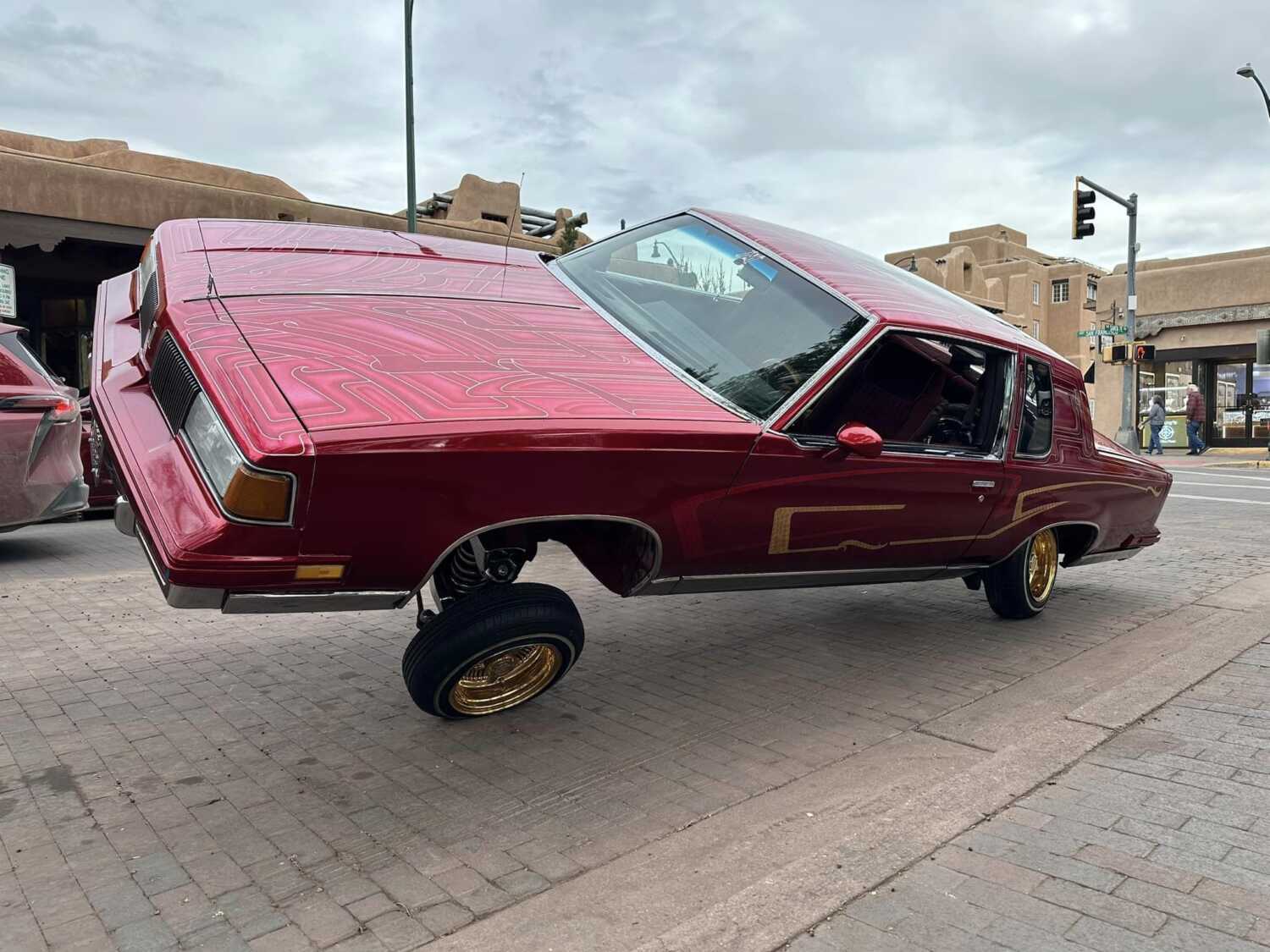
Cinco de Mayo celebrations 2024, Santa Fe Plaza, 2024 – Brandy Saturley
With Santa Fe as our home base for five days the plan was to begin with visiting the Georgia O’Keeffe home and studio in Abiquiu. A one hour drive from Santa Fe through valleys of brush and arid landscapes we came to a curve in the road and a destination between two mountain ranges. The O’Keeffe Welcome Centre, the meeting point to begin a guided tour of just over and hour. In the welcome centre there are a few exhibits of items from the O’Keeffe homes and her closet, some of her mid-century modern chairs, a short film and a library of books all about the artist. From her paintings, to pottery, photography, her relationships with designers from fashion to furniture and jewelry to her passion for growing her own food and cooking. There is also a gift shop that sells many unique items by local artists and of course copies of O’Keeffe’s work and her famous hats.
We board a tour bus, with a few other O’Keeffe fans and we head out with a tour guide who is not only a painter himself of forty years, but also a fine arts teacher. He tells us that he and his wife enjoyed the tour so much when they came, that he ended up taking on the job of tour guide, and what a wonderful, passionate and informative tour we enjoyed. We began with her garden and learned of the only two days per week local irrigation system called acequia, in this remote climate. I did not know she was such a committed gardener and she grew most everything she would need to sustain her in this desert locale.
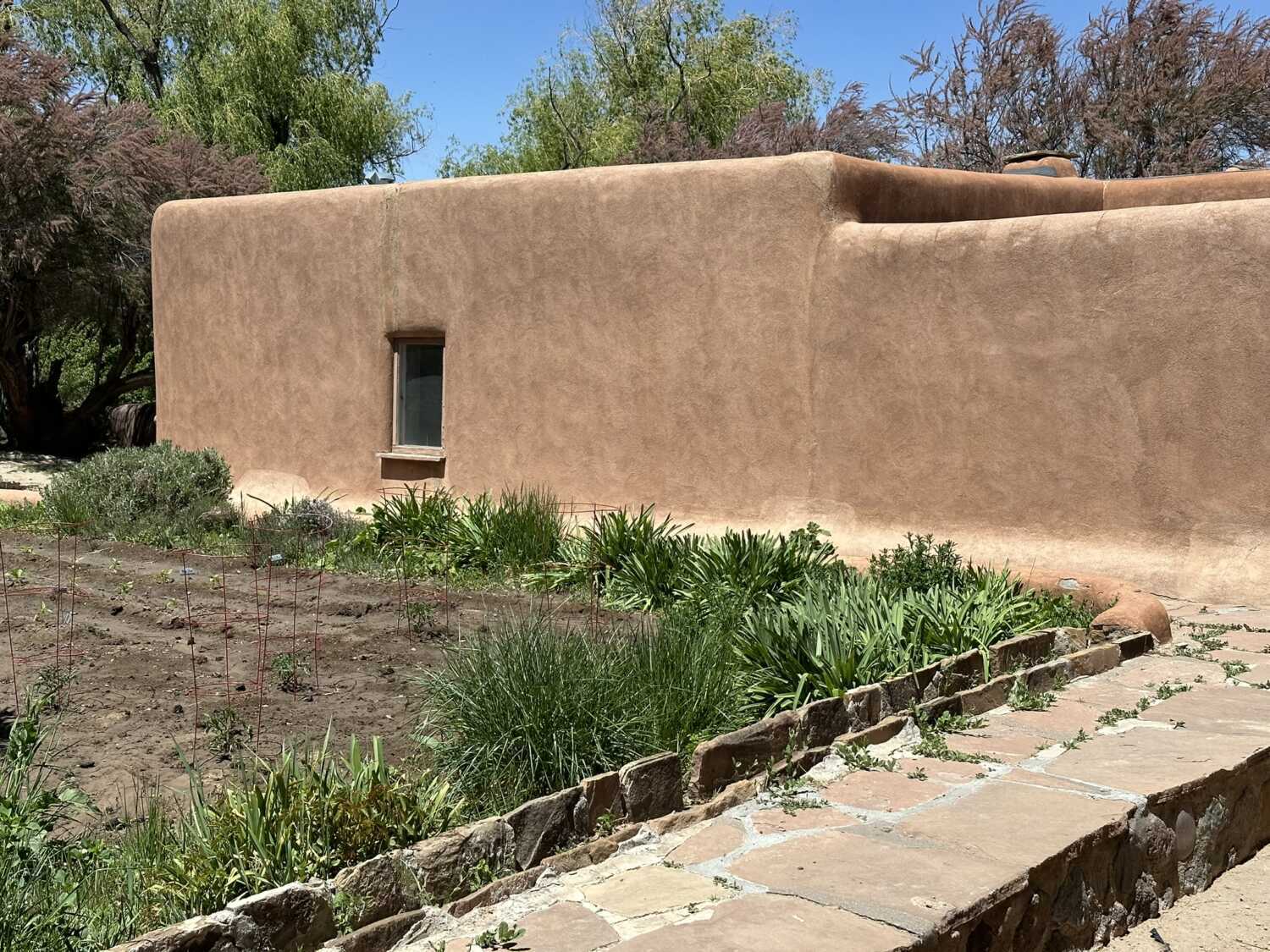
Georgia O’Keeffe home garden, Abiquiu, New Mexico, 2024 – Brandy Saturley
After, we entered through a tiny side door to her inner courtyard, depicted in many paintings and photographs of the iconic artist over the years. It was a hot and windy day, the sand under your feet in the courtyard reflects the red and earthy tones of the adobe structure. It is here you begin to feel her presence, or at least I did, as I drifted off into the moment feeling and hearing the wind, inhaling the dry smells and noticing the shadows cast by the mid-day light. This indeed was a place for an artist to live and work, and that artist was Georgia O’Keeffe herself. After talking about her ultimate reason for buying this place in 1945, the door in the courtyard, which she painted many times over the years.
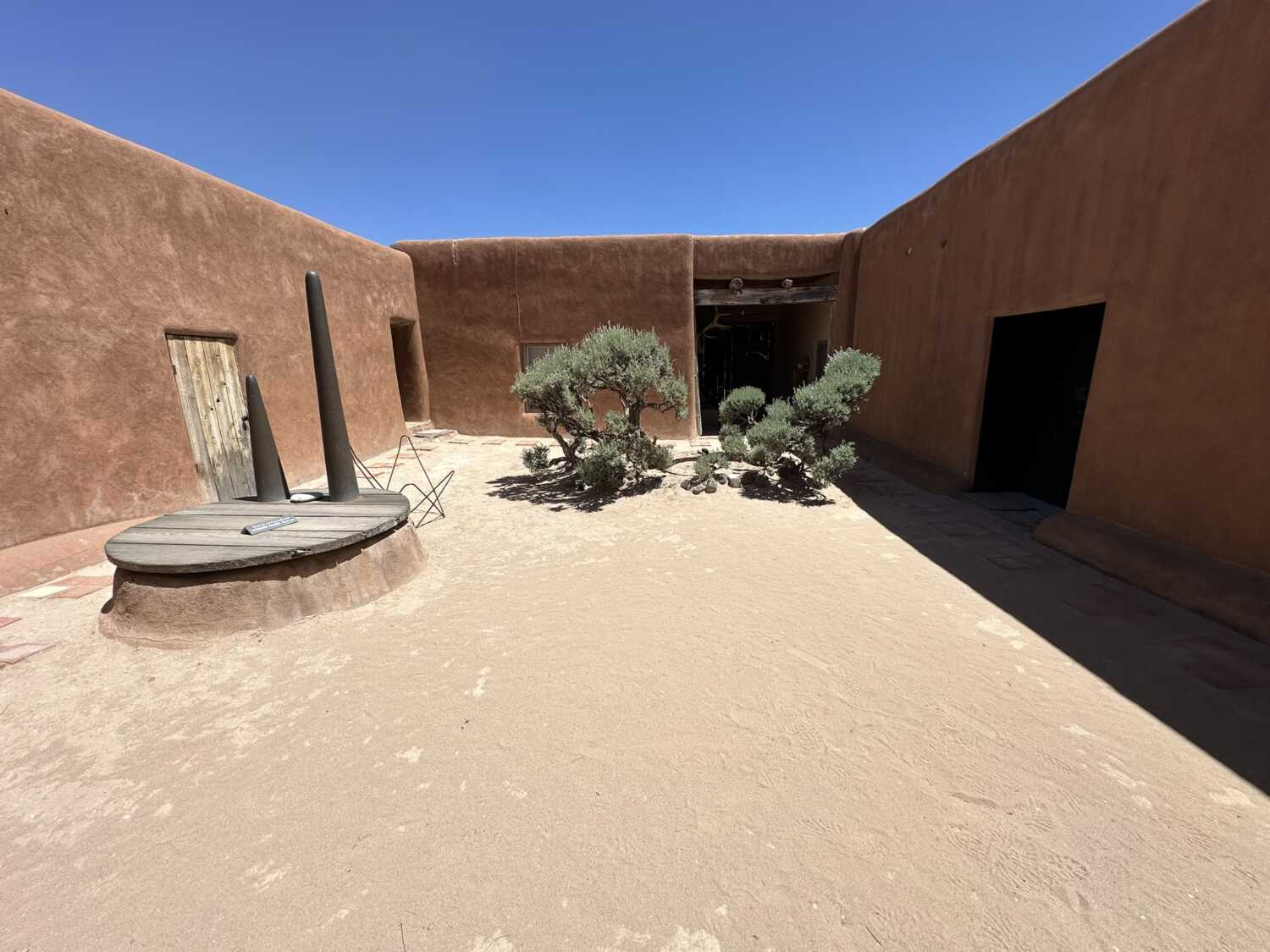
Georgia O’Keeffe Home – courtyard and door, Abiquiu New Mexico, 2024, Brandy Saturley
Having to leave the courtyard is difficult, but I knew it led to her living room and the beautiful picture window and skylights within, and I was ready to enter that home where she spent at least half her year every year until her death at 98 years old. A good long life, likely due to her mostly vegetarian diet of fresh foods and her active lifestyle in the garden, the landscapes and the studio. The dining room is next and comes with a window back into the courtyard, a small nook fireplace and a wooden table with sawhorses for legs. The style is modern, practical and minimalist, from mid-century modern furniture to simple wooden structures. All the lights hanging from the ceiling are just bulbs hanging from wires, with the exception of the hanging light in this area, it is simply and round paper shade of white, from her time in Japan, not Ikea.
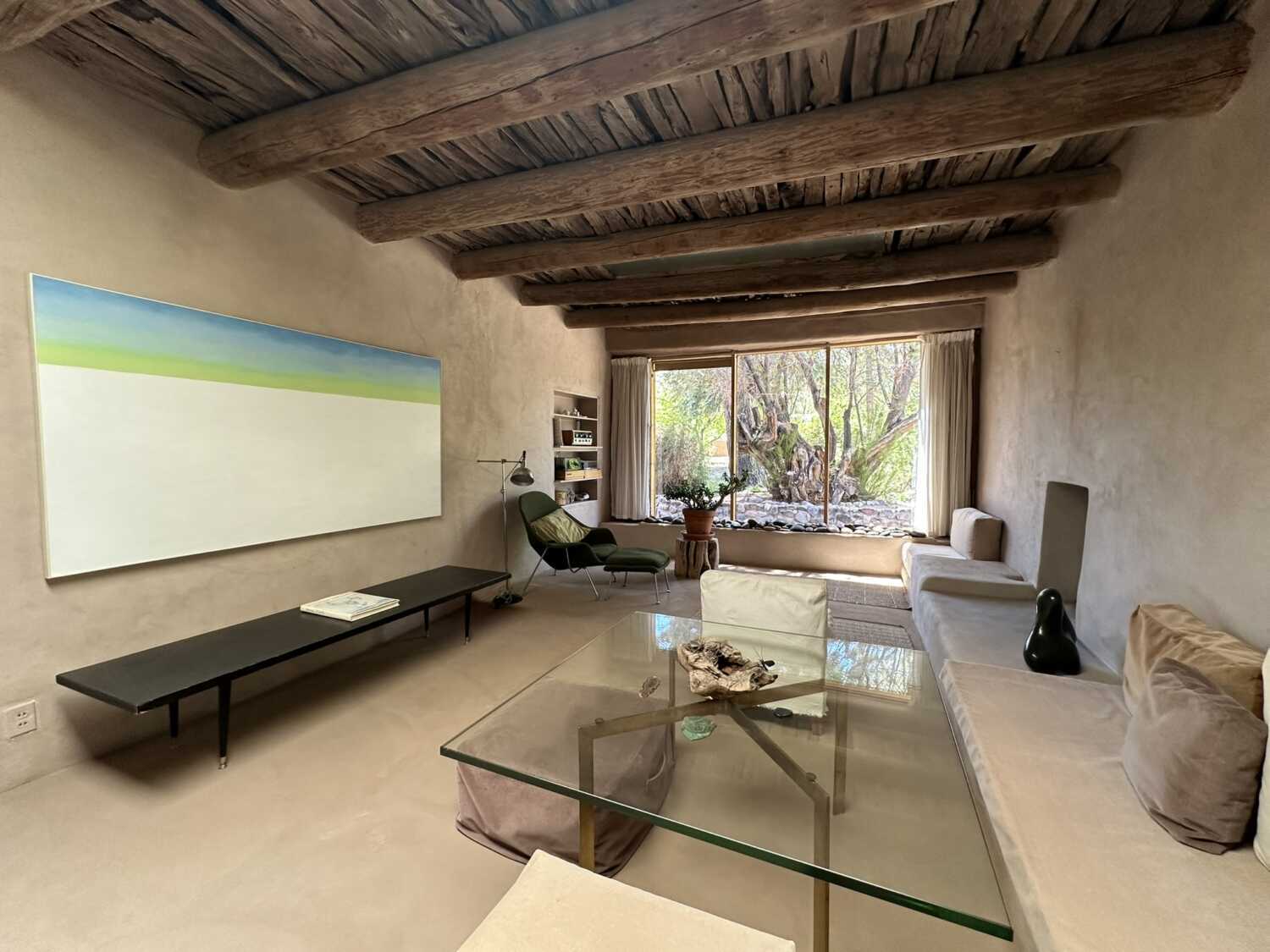
O’Keeffe Home Abiquiu, New Mexico, 2024 – Brandy Saturley
From the dining room we can peer through another window that opens to another inner courtyard where her famous spiral sculpture sits, wooden slats across the roof and mostly open to the elements. The light here is magnificent and glowing, there is a real warm yellow cast to the light in New Mexico, quite the contrast to another favourite of mine and O’Keeffe’s, Hawaii’s light is much cooler blue in contrast.
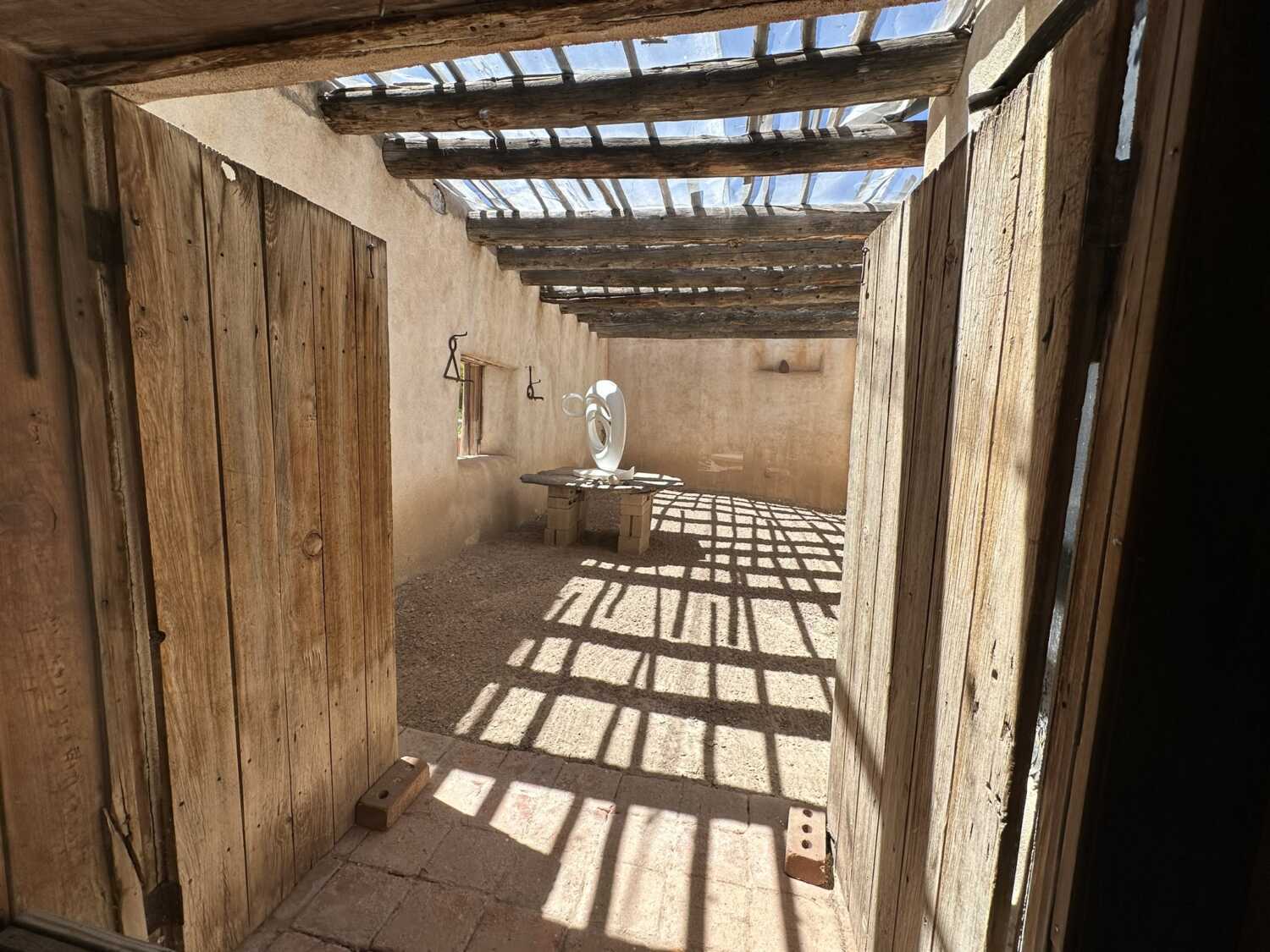
O’Keeffe Home and Studio, Abiquiu New Mexico, 2024 – Brandy Saturley
From region to region, colors change dramatically. In New Mexico, the light encompasses a full spectrum of colors, reflected both in the landscape and the sky, offering a broader array of shades than almost anywhere else. I have personally counted around 50 shades of green in the landscapes, and the sky’s personality shifts daily. The seasonal changes are remarkably distinct, and the transformation of light is truly wondrous. Consider how changing the color of sunglasses alters your perception of light; that’s akin to how the light itself changes in New Mexico. However, while New Mexico’s light is captivating, it isn’t necessarily better for painters. North light, which is more neutral and blue, is often preferred for painting. The yellow tint of southern light can affect color perception. What makes New Mexico’s light so fascinating is its impact on the landscape, rendering colors unlike those found elsewhere in the country. Each season offers a broad range of colors: Winter presents stark contrasts, Spring bursts with green, Summer is rich with vibrant hues, and Autumn is golden and vivid blue.
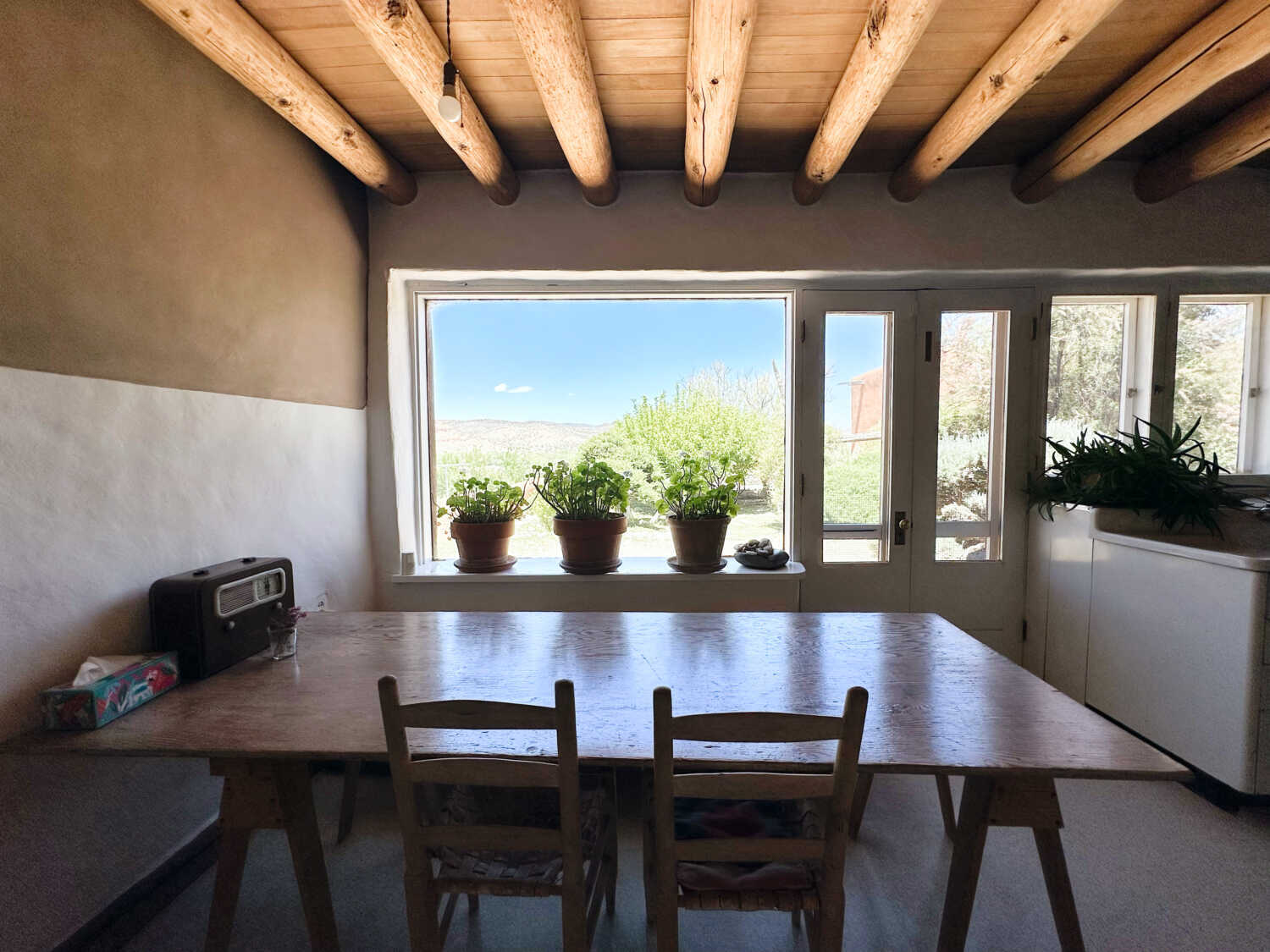
O’Keeffe home in the kitchen, Abiquiu New Mexico – Brandy Saturley
Back on the tour we enter the kitchen with another beautiful view and gorgeous light with root cellar off the kitchen and O’Keeffe’s own plants lining the window like she still lives in this place today. Off the kitchen a big pantry where you can see her canning, some old linens, wine and champagne bottles, as she did have a dinner party now and then between her work and travels. Another interior courtyard and three private guest rooms, if only we could stay one day!
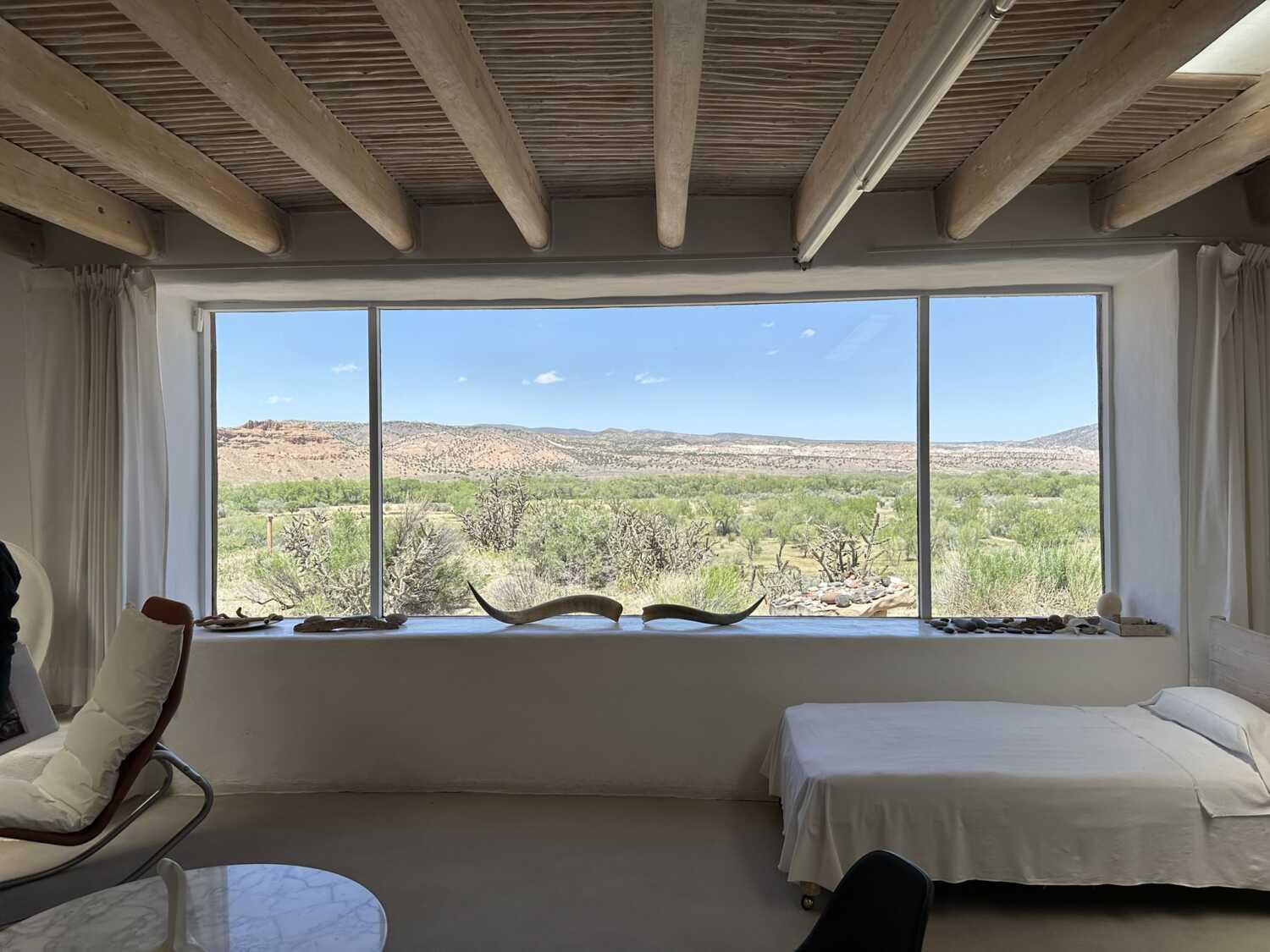
Georgia O’Keeffe studio view – Abiquiu New Mexico, Brandy Saturley 2024
Across this courtyard and parking garage we find the studio building, and it is truly an artist’s paradise. With another big picture window and view of the landscapes and mountains in the distance, the light is everything in this room, it is cooler than the rest of the house, an almost blue light in this room. We find remnants of the artist, some bones, and a collection of rocks. A fireplace, record player, books and a long table used for working. We find an easel, typewriter and storage for paintings. We find a telephone with a hand written contact list beside. The names Arturo and Ansel stand out to me, as her famous friend and iconic landscape photographer Ansel Adams is obviously the Ansel whose phone number is written here. Arturo was her assistant at the end of her life, an artist and potter, he taught her to work with clay when she was in her 80’s. Like I often say, Artists never retire. They may find themselves with limitations as they age, but this offers a challenge and the path to experiment with making art in new ways and new mediums.
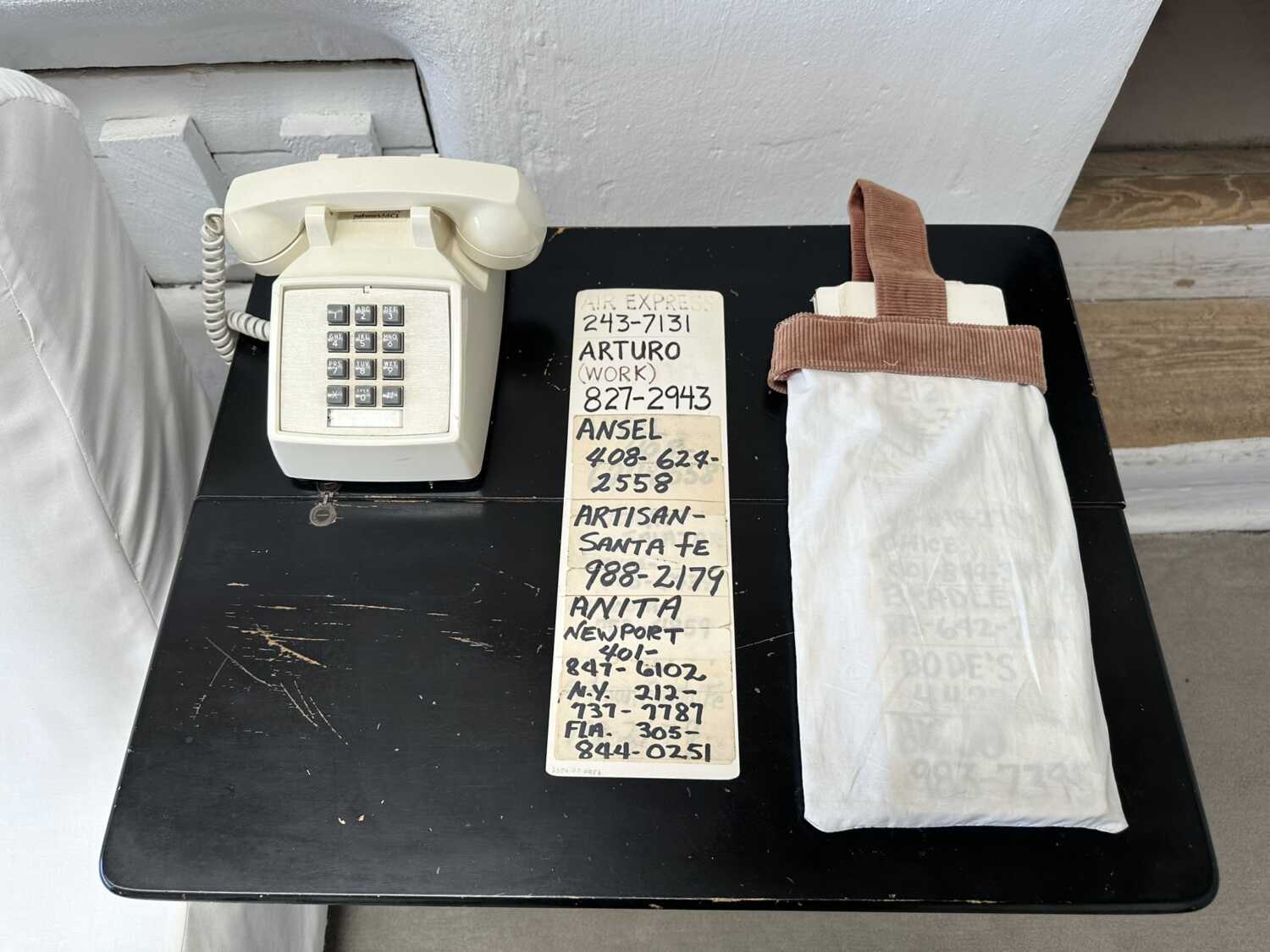
Georgia O’Keeffe telephone contact list, Ansel Adams, 2024 Brandy Saturley
Then we walk through her ensuite and closet where her famous black dress hangs, along with many other dresses. A tall narrow door provides passageway into her bedroom, which is made for a bed and not much else and it comes with another iconic view painted by O’Keeffe. The curved road, landscapes, and mountains. This room is all window, and her bed is placed in a way so that she can see the view every morning. Though this was her primary residence and studio, O’Keeffe came and went between her other home at Ghost Ranch, which was her summer place.

Georgia O’Keeffe closet and clothes in Abiquiu home – 2024, Brandy Saturley
As an artist who paints and takes photos I can see why she settled here in her middle age, she knew it would be a place that would fulfill the vessel for years to come, and as she aged and could travel less, this place would sustain the artist impulses. The energy in this place is not only because it was hers, it is also because of the place itself, it feels old, the mountains have stories to tell from centuries of inhabitants and Earthly changes. You can feel the universe here, it is spiritual, it allows you the peace to think and go within, while also being connected to the Earth and nature. I wanted to sit here all day and paint, observe, hike and explore. It is a special place, a scared place, worth many more visits. I can’t help but wonder what O’Keeffe would think of her home now a museum where strangers wander through listening to stories of her time in this place. Thank you Georgia, lovely to be in your presence once again.
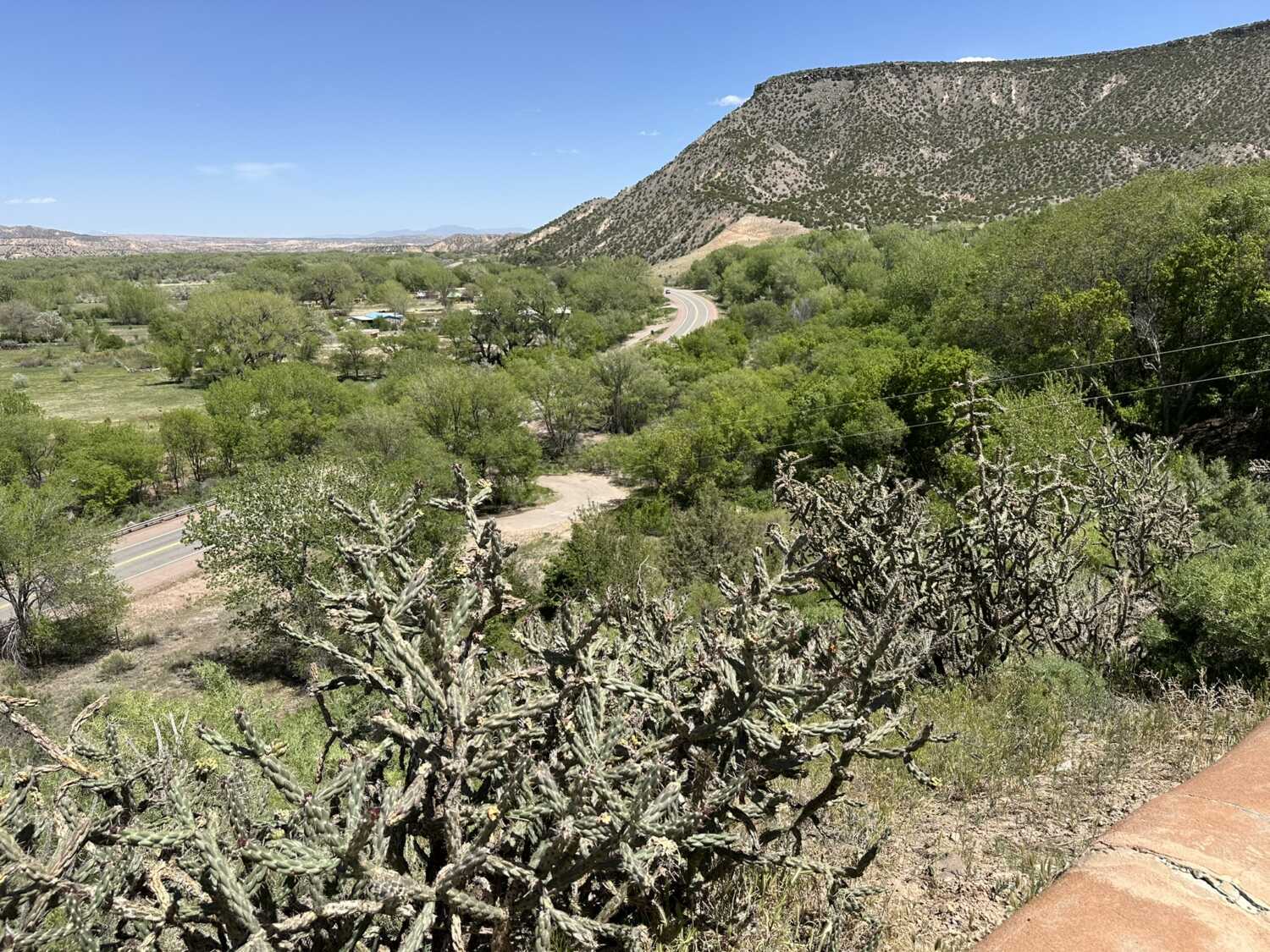
View from Georgia O’Keeffe’s bedroom – Abiquiu, New Mexico 2024 Brandy Saturley
Read about my time following O’Keeffe on Maui.
See more photos from Georgia O’Keeffe Home and Studio Tour – Abiquiu, New Mexico

